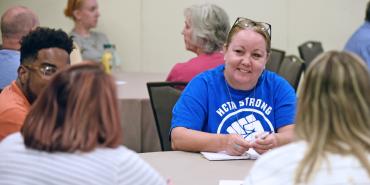As many educators will attest, getting students to synthesize accurate information can be a herculean task, especially when it’s competing with flashy stories that contradict well-researched facts and take root in your students’ heads and in your classroom.
“Did you know that the COVID-19 vaccine has killed more people than it’s helped?”
“I heard Joe Biden got impeached already.”
“Wow, the National Institutes of Health published a paper claiming that cannabis cures cancer!”
It can be scary to see bad information spread so easily among young people, but there is good news because there are concrete tactics you can take right now to protect students from spreading bad information. At “Recognizing and Dismantling Disinformation with Secondary Students,” a workshop at the AFT TEACH conference, AFT member Toni Bourgea and Cary Cuiccio, a consultant who helped develop AFT’s disinformation toolkit, provided a tangible road map to ensuring everyone is better insulated from “fake news.”
Misinformation, disinformation and malinformation
Bourgea and Cuiccio explained that there are actually three categories of bad information or “fake news.” The first is “misinformation” This is false information, though not created or shared with the intent to deceive. Think of an established news source that erroneously reports a detail, which it later retracts.
The second is “disinformation.” This is information created specifically to mislead, harm or manipulate. We have tragic examples from history when peaceful groups of disenfranchised people have been deemed “dangerous” and “violent” to justify unjust actions against them.
Last, we have “malinformation.” This is information that is true, but which is presented without context so as to hide the truth of the claim. Calling a movie “the No.1 comedy” in America obscures the fact that it may be underperforming overall, even if it was the best-performing comedic film at a moment in time.
The danger of bad information and how to guard against it
Not all versions of bad information are directly harmful, but as the presenters showed, bad information often leads to actions that can have negative impacts on our society. The Jan. 6 insurrection, which sought to overturn a democratic election and dismiss the will of American voters, was spurred by disinformation about the results of the 2020 presidential election. And now we are seeing people who were duped by a concerted disinformation campaign be arrested, fined and imprisoned for following bad information to its equally bad conclusion.
And while mis-, dis- and malinformation are rampant, Bourgea offered five simple steps you can take to help students be better critical thinkers.
First, it’s important to show empathy by listening to them instead of being dismissive or offering immediate fact checks. It’s crucial that a student spreading bad information knows you are listening by getting them to talk about why they believe it and their other thoughts on the subject.
Second, ensure that students understand the importance of discerning between credible news sources vs. less-credible sources that may have an ideological slant or financial interest in bad information.
Third, as part of that conversation, assure them that you understand the difficulty of trusting sources and share situations when you were misled.
Fourth, try not to shame the student by involving others. No one likes to be wrong, especially in public.
Last, be sure to use inclusive language, which assures the students that you (along with everyone else) are impacted similarly by bad information. Once you are on the same side, you’re more likely to convince them.
[James Hill]

